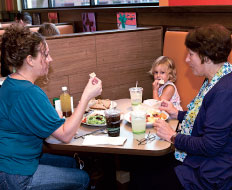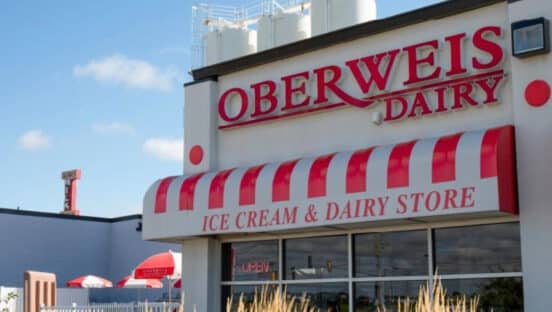Customers continue to place a premium on value, and several quick-service and fast-casual brands have found that an engaging and effective loyalty program can be one of the best ways to achieve a value position without simply slashing prices.
But loyalty programs aren’t a one-and-done process. Not only do they take time to create, craft, and hone, but to squeeze the most out of them as possible and keep customers coming back for more, loyalty programs also require frequent updating, revamping, and overhauling.
When Menchie’s leadership team sat down to revamp the brand’s paper punch card to take advantage of newer technology, they first considered the brand’s mission of making guests smile.
The result was the mySmileage plastic wallet card–based program, in which customers earn one smile—similar to a point—for every dollar they spend. Guests can redeem 50 smiles for $5 in Menchie’s money, which is loaded directly onto the card.
Menchie’s CEO Amit Kleinberger says the mySmileage program has proved a success in terms of increasing customers’ purchases, with more than 3.2 million program participants spending an average of $1 more per order than guests who aren’t members.
Pamela Sullins, director of client services at Kobie Marketing, a firm that specializes in customer rewards programs and loyalty marketing solutions, says the goal when revamping any loyalty program should primarily be to increase revenue and customer retention, while also extending the reach of the brand with guests and fans.
“There has to be that brand experience and a pathway from a program perspective to continually re-engage to keep guests coming back,” she says.
Kleinberger says that while most brands have loyalty programs, it’s the programs that allow the customer to fully engage with the brand—not just earn rewards—that translate into increased revenue.
“A loyalty program needs to have a special name, look, and feel,” Kleinberger says. “It really needs to be holistically connected to the brand and different from any other loyalty program out there.”
When revising a loyalty program, brands must incorporate the ability to measure the effectiveness of a program, Sullins says.
“While it can be tempting to measure success by how many customers sign up for a program, a high volume of members doesn’t always mean a high program performance,” she says.
Brands also need to consider all costs involved in implementing the program—including marketing, IT support, operations, and rewards costs—when calculating increased revenue, Sullins says. If a concept doesn’t track this data, then it can’t determine if the revised program is successfully increasing revenue.
A revamped loyalty program must also be simple enough that staff can easily articulate how the program works to customers, Sullins says. Further, the rewards offered in the program need a good value proposition for customers.
According to a report on loyalty marketing by Technomic, loyalty-program members visit a restaurant 82 percent of the time because of the value of the reward; 16 percent visit out of brand loyalty.
“We often recommend that brands start with a typical one-to-one reward program, such as you spend $100 and receive a coupon for $10,” Sullins says. “Once you have a strong base program, you can build in other offers, such as surprise-and-delights, special offers, or double points.”
Many newly revamped programs are now incorporating games into loyalty programs, Sullins says, giving fans the ability to earn points through Facebook or mobile apps, thus increasing customer appeal.
Zoës Kitchen recently revised its loyalty program to combine it with its new L.I.F.E app, which helps customers track life goals, such as healthy eating habits, exercise, and giving back to the community. Program participants earn goodies from Zoës for meeting life goals and by uploading purchase receipts from the fast-casual restaurant chain.
Zoës Kitchen has built upon its basic loyalty program concept by allowing guests to share the treats they earn through mobile technology. “If they know that a friend is having a tough day, they can use the L.I.F.E. app to give them their credit for a piece of free chocolate cake,” says Rachel Phillips, vice president of marketing for Zoës Kitchen.
The brand also uses data-capturing capabilities in its revised loyalty program. When customers upload a store receipt for loyalty points in the L.I.F.E. app, for example, they are prompted to answer three survey questions.
“Previously, we found it challenging to get feedback from customers because it required them to go online after they left the store,” Phillips says. “One of the key advantages of the loyalty program has been getting immediate feedback from our guests that we can use to improve our customers’ experience.”
Another concept, VooDoo BBQ & Grill, uses customer data captured from its loyalty program to track customer visits and connect with guests based on their dining frequency. “If a customer hasn’t visited us in a while, we will send them an e-mail to encourage them to come dine with us and may even offer an incentive to return,” says Jack Flechner, operating partner of The BBQ Boyz, which owns the brand’s Florida-based units.
Sullins says it is important when updating loyalty programs to have a clear value proposition for both short-term and long-term value seekers. “Some customers will want to earn rewards quickly, while others enjoy saving up for a larger reward,” she says. “You should incorporate both customer types in your new model.”
She says it’s also smart to ensure customers aren’t forced to jump through hoops or wait a long time to earn their first reward.
When Menchie’s customers sign up in the store or online for a mySmileage card, for example, they receive 25 smiles for registering and will get a bonus 10 smiles if they return to one of the brand’s stores within seven days. Kleinberger says that within two visits, a customer can be more than two-thirds of the way to earning $5 in rewards.
“To have a high-performing rewards program, you really have to connect with the customer and give them a value,” he says. “Brands that are able to come up with something unique that meets both of these criteria will enhance their brand and their overall bottom line.”













